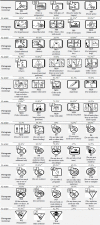Guessability of U.S. pharmaceutical pictograms in Iranian prospective users
- PMID: 32256894
- PMCID: PMC7104798
- DOI: 10.18549/PharmPract.2020.1.1705
Guessability of U.S. pharmaceutical pictograms in Iranian prospective users
Abstract
Objective: This study examined the gueassability of US pharmaceutical pictograms as well as associated demographic factors and cognitive design features among Iranian adults.
Methods: A total of 400 participants requested to guess the meaning of 53 US pharmaceutical pictograms using the open-ended method. Moreover, the participants were asked to rate the cognitive design features of each pictorial in terms of familiarity, concreteness, simplicity, meaningfulness and semantic closeness on a scale of 0-100.
Results: The average guessability score (standard deviation) was 66.30 (SD=24.59). Fifty-five percent of pharmaceutical pictograms understudy met the correctness criteria of 67% specified by ISO3864, while only 30% reached the criterion level of 85% set by ANSIz535.3. Low literate participants with only primary school education had substantial difficulty in the interpretation of pharmaceutical pictograms compared to those completed higher education levels. Younger adults of <30 years significantly performed better in the interpretation of pharmaceutical pictograms as compared to >31 years old participants. 'Home patient care' and 'daily medication use' had no effect on guessability performance. Concerning cognitive design features, meaningfulness better predict geussability score compared to the others.
Conclusions: Several USP pictograms fail to be correctly interpreted by Iranian users and need to be redesigned respecting cognitive design features. Interface designers are recommended to incorporate more familiar and concrete elements into their graphics in order to create more meaningful pictorial symbols and to avoid any misinterpretation by the user. Much effective medication use is expected to be achieved by means of this approach, through the improvement of the communication property of pharmaceutical pictograms.
Keywords: Audiovisual Aids; Communication; Drug Labeling; Health Literacy; Iran; Pamphlets; Patient Participation; Pattern Recognition; Semantics; Visual.
Copyright: © Pharmacy Practice.
Conflict of interest statement
CONFLICT OF INTEREST The authors declare that they have no conflicts of interest to disclose.
Figures
References
-
- Bosworth HB, Granger BB, Mendys P, Brindis R, Burkholder R, Czajkowski SM, Daniel JG, Ekman I, Ho M, Johnson M, Kimmel SE, Liu LZ, Musaus J, Shrank WH, Whalley Buono E, Weiss K, Granger CB. Medication adherence:a call for action. Am Heart J. 2011;162(3):412–424. doi: 10.1016/j.ahj.2011.06.007. - DOI - PMC - PubMed
-
- Fernandez-Lazaro CI, García-González JM, Adams DP, Fernandez-Lazaro D, Mielgo-Ayuso J, Caballero-Garcia A, et al. Adherence to treatment and related factors among patients with chronic conditions in primary care:a cross-sectional study. BMC Fam Pract. 2019;20(1):132. doi: 10.1186/s12875-019-1019-3. - DOI - PMC - PubMed
-
- Oori MJ, Mohammadi F, Norouzi-Tabrizi K, Fallahi-Khoshknab M, Ebadi A. Prevalence of medication adherence in patients with hypertension in Iran:A systematic review and meta-analysis of studies published in 2000-2018. ARYA Atheroscler. 2019;15(2):82–92. doi: 10.22122/arya.v15i2.1807. - DOI - PMC - PubMed
-
- Sarayani A, Jahangard-Rafsanjani Z, Hadjibabaie M, Ahmadvand A, Javadi M, Gholami K. A comprehensive review of adherence to diabetes and cardiovascular medications in Iran;implications for practice and research. J Diabetes Metab Disord. 2013;12(1):57. doi: 10.1186/2251-6581-12-57. - DOI - PMC - PubMed
LinkOut - more resources
Full Text Sources
Miscellaneous


